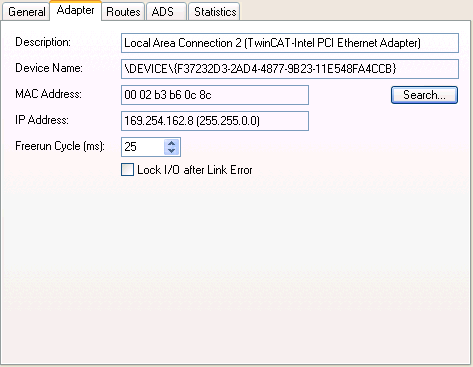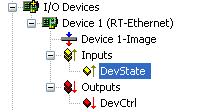Ethernet Miniport (Real-Time)
The real-time Ethernet driver allows with TwinCAT Real-Time Ethernet compatible devices a simultaneous usage of the Ethernet network for TwinCAT Real-Time applications and "regular" applications which use the operating system stack (e.g. via TCP/IP).
Real-Time Ethernet compatible devices
The real-time Ethernet Miniport driver of TwinCAT works with all Ethernet adapters of the Intel 8255x series and as well with the integrated Ethernet adapter inside the Intel I/O Hub ICH4 (e.g. integrated in i845 chipset). Nevertheless, at least Windows 2000 (or Windows XP) is required as operating system. To use the real-time environment of TwinCAT, the default operating system driver for the network adapter must be replaced with the one provided by TwinCAT v 2.9. Furthermore, an additional protocol driver "TwinCAT Ethernet Protocol" is required. How to do so, is described in Appendix C.
To verify whether compatible Ethernet adapters are available, the following dialog "TwinCAT Ethernet compatible devices" has been implemented. It can be found inside System Manager under: "Options | Show Real Time Ethernet compatible devices...":

"TwinCAT Ethernet Protocol" installed: This checkbox indicates whether theTwinCAT Protocol driver has been installed already.
Installed and ready to use devices: Shows all adapters which are currently bound to the TwinCAT driver. These adapters should be available in System Manager configurations.
Installed devices but without necessary binding to 'TwinCAT Ethernet Protokoll': Adapters which use the TwinCAT driver, but which are not bound to the TwinCAT protocol, are listed in this section. Please see installation instructions in Appendix C.
Compatible devices with incompatible driver installed: Lists all adapters which are TwinCAT Real-Time Ethernet capable if the original driver would be replaced (see: Appendix C).
WARNING: Windows Update or Service Pack installations
The advantage that Real-Time Ethernet is based on standard hardware also has a little disadvantage: The operating system identifies the hardware and tries to update the drivers for it with the latest-greatest in certain circumstances. This happens e.g. during "Automatic Updates" as well as during installation of Service Packs. After Service Pack installation, the steps of Appendix C have to be repeated, therefore. The automatic Windows update feature can be disabled (please refer to: Control Panel | System | Automatic Updates and disable first checkbox). At manual updates, the recommendation about replacing the "Intel Networking Driver" should be declined. Anyway, after Service Pack installation or update, the current configuration can be checked with upper dialog in any case.
Ethernet Miniport "Adapter" tab
Ethernet Miniport "Adapter" tab
After adding an Ethernet Miniport I/O device to the I/O configuration, the following "Adapter" tab is available on the right:

The Ethernet adapter currently selected is shown on this "Adapter" tab.
Search...: Looks for TwinCAT Real-Time Ethernet compatible devices and displays them.
MAC Address: MAC Address of this Ethernet controller (at configured network adapters)
IP Address: Settings taken from Windows Registry. These can be changed under "Control Panel | Network Connections" in the TCP/IP 'Properties..' section.. If Real-Time Ethernet and "normal" Ethernet are both used on the same system with two different network adapters, the subnet addresses of these adpaters (NICs) must differ! Nevertheless, the Real-Time Ethernet belonging devices must be configured with the same subnet address (first two quadruples) as the Ethernet Miniport adapter and vice-versa, of course.
Freerun Cycle: The cycle time used if Free-Run is active (Config Mode only), can be set here. The cycle time in Run mode results automatically in reference to the task with the highest priority linked to the variables of the adapter or one of its nodes.
Lock I/O after Link Error: If this box is checked, the process data exchange doesn't resume automatically after a resolved link problem (e.g. when the network cable has been unplugged). In such a situation, an I/O Reset is necessary afterwards, instead.
Supported devices / protocols
For a list of supported devices, seeOverview. Since TwinCAT Real-Time Ethernet supports all Ethernet protocols by principle - means standard protocols as well as special Real-Time communication protocols - this list of supported devices is just a snapshot and will be certainly extended in the future.
Status inputs and Control outputs
Underneath a configured RT Ethernet device, a status variable and a control variable shows up and can be linked to other tasks (e.g. TwinCAT PLC tasks).

Variable | Description |
|---|---|
DevState | Device status information as WORD (or UINT) variable, assumes the following values:
|
Variable | Description |
|---|---|
DevCtrl | Device control variable of type WORD (or UINT).
Has currently no impact on the network adapter! |